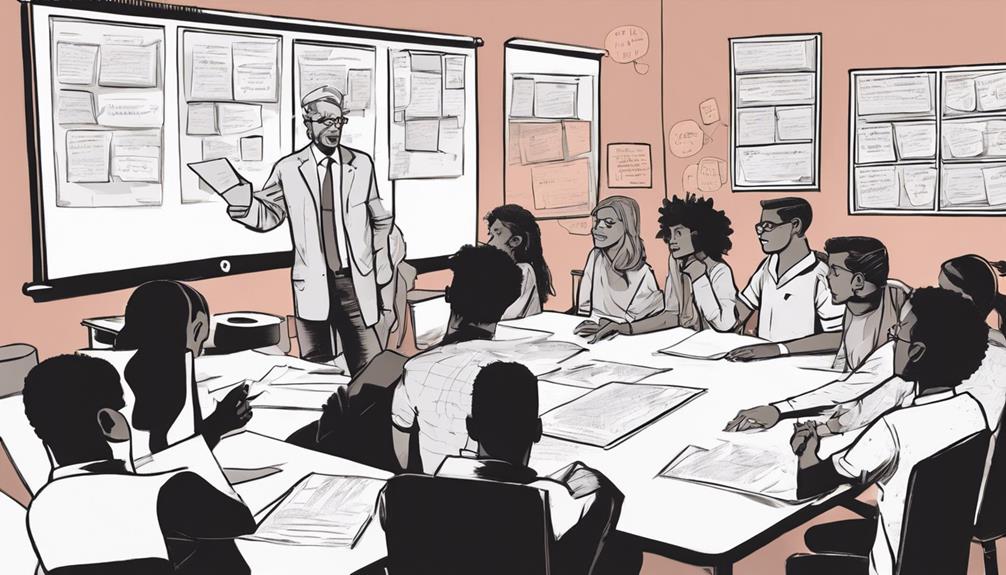Implementing the Scrum framework in high schools empowers students, teachers, and the educational system overall. Scrum enhances project management efficiency through structured sprints and daily meetings for alignment and accountability. It promotes continuous improvement, teamwork, communication, and goal setting. Students engage actively in planning and execution, collaborating in self-organized teams. Teachers benefit from facilitating collaboration, guiding colleagues for innovation, and celebrating wins. Success stories reflect increased engagement, improved outcomes, and academic excellence. High schools create a Scrum culture by embracing iterative projects, open communication, self-organization, and teacher support. This framework paves the way for high school success.
Key Takeaways
- Scrum enhances project management efficiency in high schools.
- Student engagement and collaboration improve through Scrum's structured approach.
- Teachers are empowered to guide colleagues and drive innovation.
- Success stories show increased student participation and motivation.
- High schools foster a Scrum culture by integrating its principles into daily practices.
Benefits of Scrum in Education
In education, the implementation of the Scrum framework presents numerous advantages that enhance project management efficiency and student engagement. By dividing projects into sprints, students can focus on specific tasks with clear goals, fostering a structured approach to their work.
Daily Scrum meetings provide opportunities for progress updates and planning adjustments, ensuring alignment and accountability within student teams. The feedback loops and adaptability inherent in Scrum promote continuous improvement and innovation, helping students develop agile problem-solving skills.
Additionally, the collaborative nature of Scrum encourages teamwork, communication, and goal setting, essential skills for success in both academic and professional settings. Overall, the Scrum framework offers a structured and effective method for organizing and executing projects in an educational environment.
Student Engagement and Collaboration

Enhancing student participation and fostering collaborative interactions are fundamental aspects within the educational context. In implementing the Scrum framework, students are actively engaged in project planning, execution, and reflection.
Through self-organized teams and clear goal setting, students work together to achieve project milestones. Daily Scrum meetings provide opportunities for progress updates, problem-solving, and ensuring alignment within the team. Collaboration is key as students learn to communicate effectively, delegate tasks, and support each other in reaching project objectives.
Teacher Empowerment Through Scrum

Teacher empowerment through the Scrum framework is a transformative approach that enhances collaboration and innovation in educational settings. By implementing Scrum, senior teachers can facilitate collaboration among educators, providing coaching, mentorship, and support to their peers.
Through this framework, teachers become facilitators in the Scrum cycle, guiding their colleagues to align efforts, coordinate schedules, and drive innovation in teaching methods. Celebrating wins is vital in fostering a culture of appreciation and collaboration within the school community.
This approach not only empowers teachers to lead by example but also encourages continuous improvement and experimentation in their teaching practices. Scrum empowers teachers to work together efficiently, adapt to changes, and ultimately enhance the overall educational experience for students.
Success Stories of Scrum Implementation

Several high schools have reported remarkable success stories following the implementation of the Scrum framework in their educational programs. By embracing Scrum, students have seen increased engagement, collaboration, and project outcomes.
For example, one school noted a significant improvement in student participation and motivation when working on group projects using Scrum. Another institution observed a boost in student performance and a decrease in project completion times after introducing the framework.
Teachers have also experienced positive outcomes, such as enhanced communication, streamlined project management, and improved student-teacher relationships. These success stories highlight the effectiveness of Scrum in high school settings, emphasizing the benefits of agility, teamwork, and continuous improvement in achieving academic excellence.
Creating a Scrum Culture in Schools

High schools aiming to foster innovation and collaboration among students and teachers are increasingly turning to the Scrum framework to cultivate a culture of agility and continuous improvement. Creating a Scrum culture in schools involves integrating Scrum principles into daily practices.
This includes embracing the iterative nature of projects, promoting open communication through daily Scrum meetings, and fostering self-organization within teams. Teachers play an essential role in supporting and guiding students through the Scrum process, emphasizing the importance of feedback and adaptation for growth.
Frequently Asked Questions
How Can Scrum Help High School Students Develop Time Management Skills?
Scrum can aid high school students in honing time management skills by breaking projects into sprints, setting clear goals, and tracking progress through daily meetings. It fosters adaptability, feedback loops, and continuous improvement for effective time utilization.
What Are Some Common Challenges Teachers Face When Implementing Scrum?
Common challenges teachers face when implementing Scrum include adapting to a new methodology, ensuring student buy-in, managing diverse project teams, aligning curriculum requirements with Scrum principles, and providing adequate training and support for both students and fellow educators.
Can Scrum Be Used in Non-Technical Subjects Like History or Literature?
Yes, Scrum can be effectively used in non-technical subjects like history or literature. By adapting the framework to suit the subject matter, teachers can still benefit from its structured approach to project management, collaboration, and innovation.
How Do Students Respond to the Increased Autonomy in Scrum Projects?
Students respond positively to increased autonomy in Scrum projects by embracing self-organization, setting clear goals, and taking ownership of their work. This autonomy fosters creativity, accountability, and a sense of empowerment, leading to improved project outcomes.
Is There a Recommended Size for Scrum Teams in a High School Setting?
In a high school setting, a recommended size for Scrum teams typically ranges from 5 to 9 members. This promotes diverse perspectives, facilitates efficient collaboration, and fosters effective communication. Smaller teams may lack expertise, while larger teams can face coordination challenges.
Conclusion
To sum up, embracing the Scrum framework in high school settings can lead to enhanced student engagement, collaboration, and teacher empowerment.
As the saying goes, 'Teamwork makes the dream work,' and by fostering a culture of teamwork and innovation, educators can empower students to excel in their academic endeavors.
Through clear goal-setting, daily progress tracking, and a focus on continuous improvement, Scrum can truly shape a successful learning environment for all involved.










